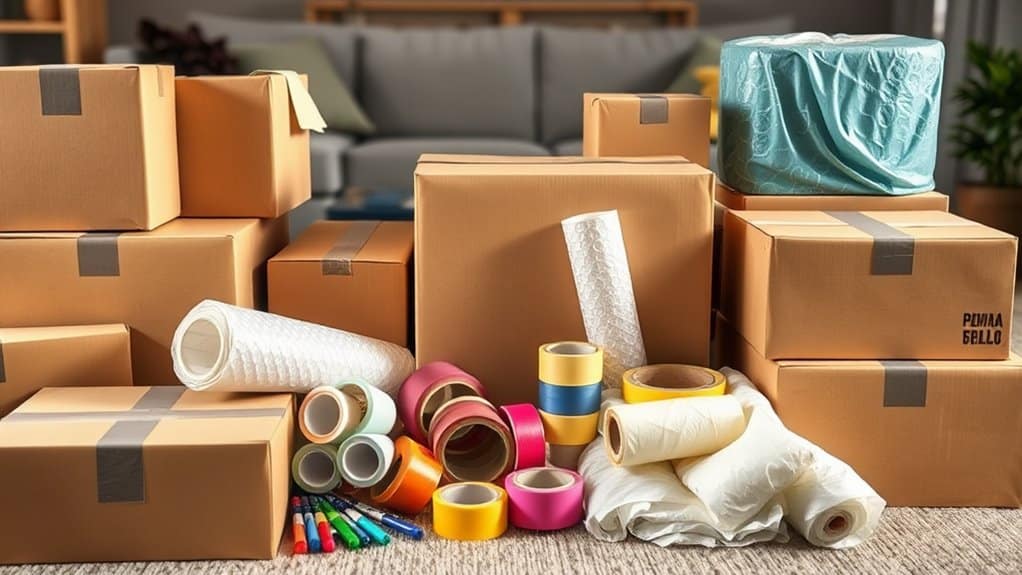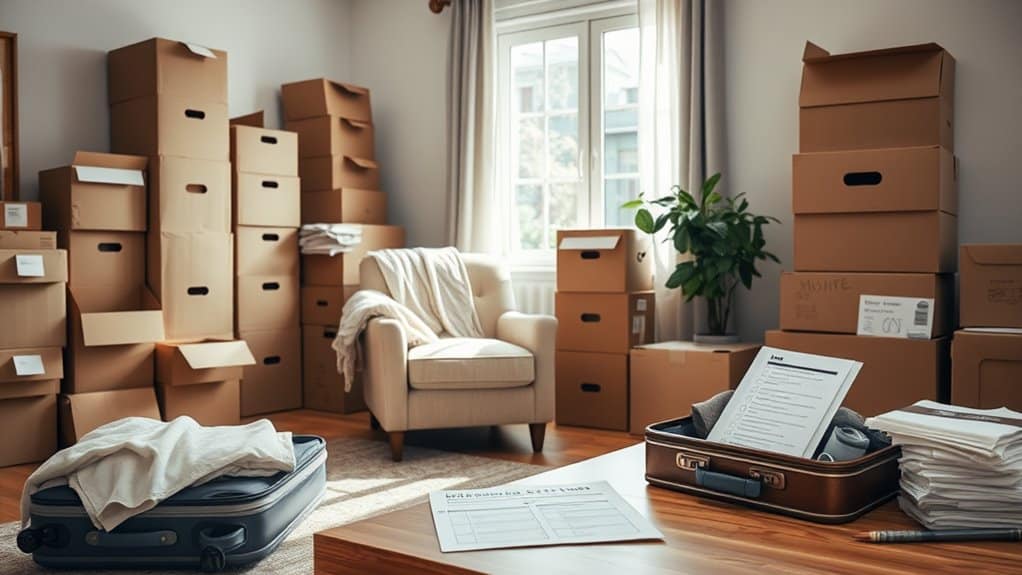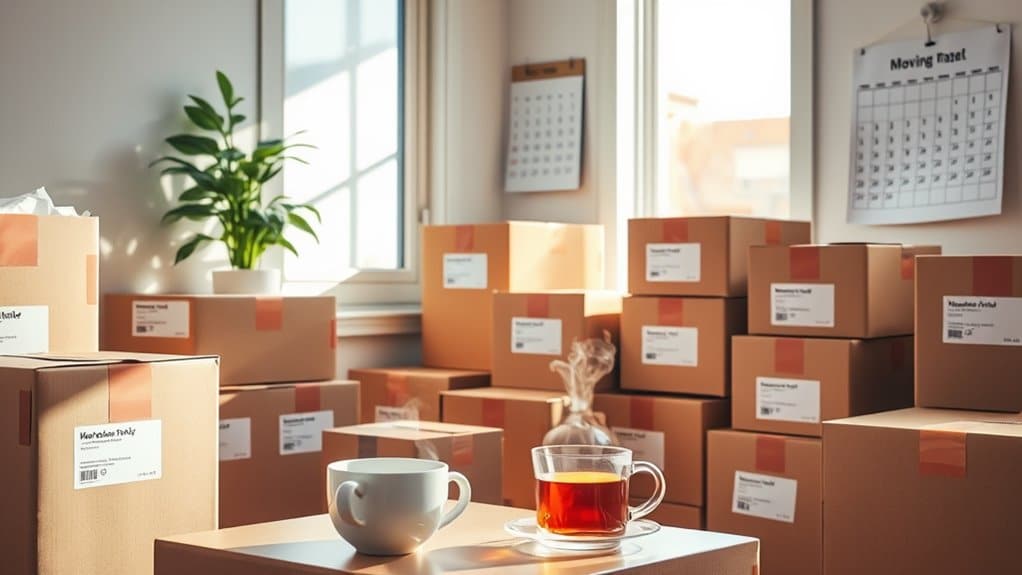
Essential Tips for a Seamless Long-Distance House Move
To ensure a smooth long-distance house move, start planning at least two months in advance. Create a detailed timeline and checklist to keep track of tasks. Research and compare moving companies, paying attention to their reputations and insurance options. Set a realistic budget that includes costs for packing supplies and utility setup.
Declutter your belongings, packing early and labelling boxes clearly to make unpacking easier. Familiarise yourself with your new area, including schools and local amenities. Lastly, manage stress by staying in touch with family and friends. By following these tips, you’ll be well-prepared for your move and can discover even more strategies along the way.
Key Takeaways
- Begin planning at least two months ahead. Create a checklist to keep track of tasks and deadlines for a smoother move.
- Research and hire reputable moving firms. Compare their services, prices, and customer reviews to make a reliable choice.
- Declutter your belongings early to simplify packing and cut down on moving costs. Focus on essential items as the moving day nears.
- Invest in quality packing materials. Use sturdy boxes and bubble wrap to safeguard fragile items, and label boxes for easy identification.
- Get familiar with logistics, such as delivery routes and local amenities. This will help manage expectations and ease your transition into the new home.
Start Early With Planning
Starting your long-distance move on the right foot relies on early planning. Aim to begin this process at least two months before your moving date, giving you enough time to compare moving companies and gather packing materials.
Creating a detailed moving checklist is crucial; it helps you keep track of tasks and set realistic deadlines, breaking the moving timeline into manageable parts. Consider utilizing resources for multiple free quotes to better understand your options for moving services.
Prioritise tasks like researching reputable movers and establishing a moving budget. This proactive approach helps reduce last-minute stress and potential delays, keeping you organised throughout. Sorting and decluttering your belongings early can also simplify packing, making it easier to decide what to keep and what to discard. Remember to consider average moving costs when creating your budget, as this will help you plan effectively.
Be sure to prepare packing materials in advance and plan for utility installations in your new home. Additionally, set a realistic timeline for packing each room, ensuring that essential items are packed last for easy access.
Develop a Detailed Timeline
Once you’ve set the groundwork with early planning, it’s time to create a detailed timeline to guide you through the moving process. A well-structured Moving Timeline ensures you stay organised and enhances your packing efficiency.
Start by gathering packing supplies 5-7 weeks before your move. This includes boxes, tape, and bubble wrap. Additionally, ensure you have enough packing materials such as boxes, tape, bubble wrap to facilitate the packing process effectively.
Next, spend 4-6 weeks decluttering and downsizing your belongings. This step not only lightens your load but also simplifies packing.
Three weeks prior, focus on packing infrequently used items like seasonal decorations and out-of-season clothing.
Two weeks out, concentrate on the kitchen; pack your kitchenware and identify essential items you’ll need immediately.
One week before the move, finalise packing and label all boxes clearly to make unpacking easier. Additionally, be sure to incorporate buffer time into your schedule to manage potential delays effectively.
Don’t forget to arrange for utility disconnections and reconnections a month in advance, and confirm moving dates with your chosen removal company.
As you prepare, coordinate transportation for your family and pets, and set up services like internet and TV at your new home.
Following this timeline will help you manage your tasks efficiently and reduce stress as moving day approaches.
Research Moving Companies

When researching moving companies, it’s crucial to compare the services they provide to ensure they meet your requirements. Check their insurance options to make certain your belongings are protected throughout the move. Additionally, it’s important to consider the company’s reputation and reviews from previous customers to gauge their reliability. Also, assess their pricing structures to prevent any unexpected costs and keep within your budget. For example, some companies may offer a fixed rate, while others might charge hourly, so choose what suits you best. Additionally, consider companies that offer binding estimates to avoid unexpected charges after entering into an agreement.
Compare Services Offered
Choosing the right moving company can significantly influence the outcome of your long-distance move. By comparing the services offered by various companies, you can make informed decisions that will save you time and reduce stress.
Consider the following key aspects:
- Types of Services: Check if the company provides full-service moves, which include packing and unpacking, or if you’ll need to manage these tasks yourself.
- Specialty Services: Assess whether they offer specialised services, such as piano moving or vehicle transport, tailored to your specific needs.
- Storage Options: Ensure they’ve secure storage facilities available, especially if there’s a gap between your move-out and move-in dates. Additionally, it’s essential to research professional movers to identify reputable options in your area.
Always verify licences and read customer reviews to evaluate reliability.
Look for companies that communicate effectively and manage complaints well. A thorough assessment of the services on offer will help you choose the right mover and ensure your belongings are handled with care during the journey.
Following these steps will lead to a smoother and more organised long-distance move.
Check Insurance Options
Evaluating insurance options is crucial for safeguarding your belongings during a long-distance move. Start by understanding the different types of insurance available. Basic Carrier Liability is the minimum legal requirement but offers limited protection. For better coverage, consider Declared Value Protection or Complete Value Protection. If you have lightweight yet valuable items, Assessed Value Protection might be suitable.
Check whether your current home insurance or contents insurance covers your move, as this could save you money. Ensure the insurance provider offers nationwide coverage, particularly for long-distance moves. Look for companies that specialise in long-distance insurance, as they often provide tailored policies that meet your needs. Additionally, it’s important to partner with reputable moving companies that can offer reliable insurance recommendations.
Before moving, document your belongings with photos, create itemised lists, and keep original receipts to support any claims.
Make sure you understand the policy’s terms and act quickly if you need to make a claim. With the right insurance in place, you can move confidently, knowing your belongings are protected throughout the journey.
Evaluate Pricing Structures
Once you’ve secured the right insurance for your belongings, the next step is to grasp the pricing structures of moving companies. Understanding different pricing models and cost factors will help you make an informed choice.
Moving companies generally operate under one of these pricing models:
- Flat Rates: A fixed price for specific routes.
- Weight-Based Pricing: Charges based on the weight of your possessions and the distance of the move.
- Hourly Rates: Common for local moves, typically ranging from £60 to £180 per hour.
When you’re comparing quotes, keep in mind these cost factors that can significantly affect your final bill:
- Distance: Longer moves usually incur higher costs, with the national average cost for long-distance moves being around $3,062.
- Volume of Items: A larger quantity of belongings will increase expenses.
- Services Required: Additional services like packing, unpacking, and storage will add to your total.
Also, be aware of potential extra costs, such as packing supplies and fees for handling special items.
Organize a Moving Binder
A well-organised moving binder can be your best ally during a long-distance house move, helping you keep track of every detail. Start by choosing a sturdy binder and divide it into sections with tabs for easy access. This organisation will significantly streamline your moving process. Here’s a suggested layout:
| Section | Content Description | Purpose |
|---|---|---|
| Household Inventory | Detailed list of all items | Helps track belongings and check them off during packing |
| Moving Timeline | Checklist of tasks and deadlines | Keeps you on schedule |
| Financial Tracking | Receipts, quotes, and budgets | Manages expenses and budgets |
| Important Documents | Contracts, insurance information, etc. | Centralises essential paperwork |
Use inventory sheets to catalogue your belongings, including photos for reference during unpacking. A moving binder keeps everything organized and ensures that important information is at your fingertips. Keep the binder in a secure yet accessible location throughout the move. Regularly update it to reflect any changes, and use it to confirm arrangements or address unexpected issues. With a well-organised moving binder, you can approach your long-distance move with confidence and ease.
Set a Realistic Budget

When planning your long-distance move, it’s crucial to identify all potential expenses, including labour costs and packing materials. Distance and Location can significantly impact your overall moving costs, so be sure to set aside some contingency funds for any unexpected costs that may crop up during the process. By establishing a realistic budget, you’ll feel more in control and ready for the journey ahead. For example, if you’re hiring a van, factor in fuel and tolls as well.
Identify Moving Expenses
Moving can be stressful, particularly when budgeting for a long-distance relocation. To ensure you’re financially ready, it’s crucial to identify your moving expenses. A clear breakdown of costs will help you plan effectively and avoid unexpected surprises.
Consider these cost estimation strategies:
- Distance and Size: Think about how far you’re moving and the size of your home. For example, moving a one-bedroom flat across 1,000 miles typically costs between £1,200 and £3,800. Keep in mind that a cross-country move can range from $1,000 to $20,000, significantly affecting your budget.
- Service Type: Decide whether to hire professional movers or take a DIY approach. While hiring movers offers convenience, it usually comes with higher expenses.
- Additional Costs: Remember to include utility setup fees, temporary storage, and expenses related to decluttering.
Allocate Contingency Funds
After calculating your moving expenses, it’s important to set aside contingency funds to ensure you’re financially equipped for any surprises that may occur during your long-distance move. Budgeting for contingencies is vital; it allows you to handle unexpected costs without upsetting your overall budget. Allocate a portion of your funds specifically for unforeseen expenses such as utility deposits, meal costs, and potential damages. Additionally, it’s essential to remember that average costs for long-distance moves can vary significantly, which further emphasizes the need for a solid contingency plan.
Here’s a handy table outlining some common unexpected expenses:
| Expense Type | Estimated Cost | Notes |
|---|---|---|
| Utility Deposits | £150 – £300 | Varies by provider |
| Temporary Storage | £100 – £300/month | Depends on duration required |
| Meal Expenses | £50 – £150 | During the move |
| Internet Setup | £100 – £200 | Installation fees |
| Miscellaneous Damages | £50 – £500 | Damage to belongings |
Sort and Declutter Items
Starting your decluttering journey early can significantly reduce stress during a long-distance house move. Adopting a decluttering mindset is crucial, and effective sorting strategies will help you manage the process smoothly.
Tackle one room at a time to avoid feeling overwhelmed. Here are some practical tips to get you started:
- Set aside dedicated decluttering time each week to keep the momentum going.
- Use the 5-year rule: If you haven’t used an item in five years, consider letting it go.
- Sort items into keep, donate, sell, and discard piles for clarity.
As you sort through your belongings, be firm in your decisions. Consider sentimental value but focus on what’s truly essential.
Create an inventory list to track what you’re keeping, and label your boxes to simplify unpacking later. By planning ahead and coordinating your decluttering with your moving schedule, you’ll ensure a smoother transition, saving time and effort.
Embrace the process; less clutter means less stress!
Invest in Quality Packing Supplies

When planning a long-distance move, investing in quality packing supplies is essential. Sturdy boxes and specialised packing materials ensure your belongings arrive safely.
Avoid cheap alternatives that risk damage; your items deserve reliable protection during transit. For example, using bubble wrap for fragile items can prevent breakages, while heavy-duty boxes can withstand the rigours of moving.
Choose wisely to keep your possessions secure.
Choose Durable Packing Materials
Choosing durable packing materials is crucial for a successful long-distance move, as the right supplies help protect your belongings during transit.
Investing in quality packing materials not only safeguards your items but also streamlines the packing process. Here are some key components to consider:
- Sturdy Boxes: Use double-walled cardboard boxes for heavy or fragile items, and specialised boxes for delicate possessions like crockery or electronics.
- Protective Wraps: Employ bubble wrap and packing paper to cushion your items. Packing peanuts or foam padding can fill gaps in boxes to prevent movement.
- Reliable Sealing Supplies: Strong packing tape and permanent markers are essential for securely sealing boxes and clearly labelling their contents.
Prioritize Specialized Supplies
After confirming you have sturdy packing materials, it’s time to focus on specialized supplies that can help make your long-distance move smoother. Quality packing supplies are crucial for protecting your belongings.
Begin by gathering a range of box sizes to ensure items fit snugly and don’t shift during transit. Use bubble wrap or similar protective materials for fragile items, and invest in strong packing tape and dispensers to keep your boxes securely closed.
Consider using specialty boxes, such as dish packs and wardrobe boxes, which are tailored for specific items. Don’t forget furniture pads and moving blankets; these will safeguard your larger furniture from damage.
Ziplock bags are useful for keeping small parts, like screws and bolts, organised.
Employ effective packing techniques, such as wrapping delicate items in clothing or linens to save space. Clearly label your boxes with thick permanent markers to easily identify contents at your new home.
Avoid Cheap Alternatives
Investing in quality packing supplies is crucial for a successful long-distance move. While it may be tempting to look for cheaper options, this can lead to significant problems. High-quality packing materials not only protect your belongings but also save you from unnecessary stress and potential financial losses.
Consider these essential packing materials for your move:
- Sturdy Cardboard Boxes: Opt for double-walled boxes for the durability needed during long-distance transport.
- Bubble Wrap: This cushioning material safeguards fragile items against breakage while in transit.
- Heavy-Duty Packing Tape: Choose water-resistant tape with a strong adhesive to ensure your boxes remain securely sealed.
While it might seem cost-effective to go for cheaper supplies, investing in quality pays off. Inferior materials can fail, resulting in damaged goods and wasted time on re-packing.
You want your items to arrive safely, and using the right supplies makes that possible. By steering clear of low-quality options, you can streamline the moving process and enjoy greater peace of mind.
Create a Comprehensive Inventory
Creating a comprehensive inventory is essential for ensuring a smooth long-distance move. By listing your belongings, you simplify the relocation process and reduce the chances of loss or damage. Start by using inventory software or a basic spreadsheet to organise your items effectively.
| Category | Examples |
|---|---|
| Furniture | Sofa, Bed, Dining Table |
| Electronics | Television, Laptop, Microwave |
| Kitchen Items | Pots, Pans, Utensils |
When compiling your inventory, sort items by room or type to make packing and unpacking easier. Assign box numbers and note the condition and estimated value of each item, particularly for fragile or valuable items. Taking photographs can also help document their condition for insurance purposes.
Finally, ensure you check items off during loading and unloading to verify that everything arrives at your new home. Keeping a copy of your inventory list is crucial for personal records and insurance claims, as it provides a clear overview of your belongings and their conditions. This careful preparation will help you enjoy a stress-free moving experience.
Pack Essentials Last

When preparing for a long-distance move, it’s crucial to identify your essential items and keep them close at hand.
A clear packing strategy can significantly ease the process, ensuring you have what you need when you need it. By packing your essentials last, you can streamline your move and reduce stress.
For example, pack your toiletries, important documents, and a change of clothes last so they’re readily available on arrival.
Identify Essential Items
Packing for a long-distance move can feel daunting, but identifying your essential items early can simplify the process. Knowing what to pack as your essentials ensures you have everything you need right at hand on Moving Day.
Begin by creating a list of key items you can’t do without for the first few days in your new home. Consider including the following essentials:
- Clothing for a few days
- Toiletries (toothbrush, toothpaste, soap, etc.)
- Important documents (ID, insurance papers, etc.)
Store these items in an “essentials box” and pack it last so it’s easily accessible. Clearly label the box for quick identification upon arrival.
It’s also wise to pack a separate bag for overnight essentials, which might include medications, basic kitchen items, and necessary tools like scissors or screwdrivers.
Keep Essentials Accessible
Keeping your essentials accessible during a long-distance move is crucial for a smooth transition. Start by making an Essentials Checklist to itemise everything you’ll need upon arrival.
Pack your essentials box last, including items like toilet roll, towels, basic kitchen utensils, and snacks for the journey. Don’t forget to include personal items like medication, important documents, and chargers in a separate bag.
Use effective packing techniques by clearly labelling your essentials box so it’s the first one you open in your new home. During transit, keep important items like pillows, a few days’ clothing, and water in the car for easy access. It’s also handy to have tools like scissors and a screwdriver for immediate tasks.
Once you arrive, prioritise unpacking your essentials first, using your checklist to ensure you haven’t missed anything. This organised approach will help you settle in quickly, allowing you to focus on making your new home comfortable.
Create a Packing Strategy
Establishing a packing strategy is crucial for a successful long-distance move. Prioritising which items to pack last can significantly ease the transition. By understanding packing psychology, you can enhance efficiency and minimise stress in the days leading up to your move.
Begin by packing non-essential items first, leaving daily essentials for last. Consider these categories when deciding what to pack last:
- Toiletries and personal items: Keep everyday essentials like toothbrushes and skincare products easily accessible.
- Bedding and linens: Pack these last to ensure you have a comfortable sleeping arrangement on moving night.
- Kitchen essentials: Only pack items you won’t need immediately, such as extra plates and cutlery.
Label Boxes Clearly
Clear labels on your moving boxes can significantly reduce stress during a long-distance move. By using effective labelling techniques, unpacking becomes much easier.
Start by categorising your boxes by room. Clearly label each box with the room name, such as “Kitchen” or “Bedroom,” and consider colour coding to assign a specific colour to each room. This visual aid helps you and your movers quickly identify where each box should go.
Place labels on at least two sides and the top of the boxes for better visibility. Use permanent, waterproof markers to ensure your labels remain legible, even if they get wet or worn. Avoid vague terms like “Miscellaneous”; instead, provide specific descriptions, such as “Kitchen Utensils” or “Bedroom Linens,” so you know exactly what’s inside.
For fragile and valuable items, clearly mark boxes with “FRAGILE” and use bright colours to indicate they require extra care.
Don’t forget to label essential items as “ESSENTIALS” or “OPEN FIRST” for immediate access. By organising and labelling your boxes clearly, you’ll make your move smoother and settling into your new home much easier.
Hire a Reliable Moving Company

Finding a reliable moving company is crucial for a smooth long-distance move. Start by verifying the company’s credentials. Check their registration with the relevant authorities to ensure they’re legitimate. Reading customer reviews on platforms like Google and Trustpilot can also give you insight into their reputation.
When assessing potential movers, consider these key factors:
- Experience: Choose a company with a solid track record in long-distance relocations and experience with your specific type of move.
- Estimates: Ensure they conduct a thorough walk-through to provide an accurate quote. Opt for binding quotes to avoid unexpected charges.
- Customer Service: Pay attention to how well they respond to your inquiries, looking for clear and patient communication.
Good customer service will help you gauge how they handle challenges and unexpected situations. Professionals should provide straightforward answers about their services and policies.
Investing time in researching and verifying moving companies can save you from potential headaches and ensure your long-distance move goes smoothly.
Understand Delivery Logistics
Understanding delivery logistics is crucial for a successful long-distance move. Familiarising yourself with delivery routes and schedules can help you set realistic expectations.
Long-distance movers often consolidate loads for efficiency, meaning your items may share space with others. This can result in flexible delivery windows, so be prepared for potential delays due to weather or mechanical issues.
Exact arrival times aren’t guaranteed unless you choose expedited services, which offer fixed delivery dates at a higher cost. Transit times vary based on load size and distance, so it’s wise to consider possible logistical challenges.
Using tools like the MyUnited Move Portal can simplify your moving process, enabling you to track progress and stay organised.
You might also explore specialised services, such as Value Flex crated moving for smaller shipments, which provide flexibility and efficiency.
Familiarize Yourself With the New Area

Familiarising yourself with your new area is crucial for a smooth adjustment and helps you settle in quickly. By understanding the local environment, you’ll feel more at home and connected to your community. Here are some key steps to consider:
- Identify Local Amenities: Find out where the nearest schools, supermarkets, and healthcare facilities are located.
- Explore Neighbourhoods: Use online resources to gather insights about different neighbourhoods, including average property prices and local attractions.
- Connect with the Local Community: Join social media groups or forums to engage with residents and build a network before you arrive.
Once you’ve moved in, take time to explore your surroundings. Walk or cycle to discover local parks, restaurants, and shops.
Attend community events to immerse yourself in local culture and meet new people. Asking current residents for recommendations can uncover hidden gems in your area.
Keep a record of your favourite spots and routes. By investing time in getting to know your new environment, you’ll foster a sense of belonging and ease your transition into this exciting chapter of your life.
Plan for Utilities Setup
Setting up utilities in your new home is an essential step that can significantly affect your moving experience. Start by identifying your current utility providers for electricity, water, gas, and internet. Inform each provider about your moving date to initiate the transfer process, and ensure you request final bills and any applicable refunds.
Next, research utility providers available in your new area. Make a comprehensive list of all the utilities you need to transfer, and reach out to both your current and prospective providers well in advance to arrange installations.
It’s best to have all utilities set up a few days before your moving day to avoid any disruptions.
Don’t forget to arrange for final meter readings at your old property and provide your new address to ensure any final bills reach you. Keep all important documents handy, including account numbers and contact details, as you coordinate with your moving company regarding utility arrangements.
Finally, when you arrive at your new home, check that all utilities are functioning correctly. A smooth utility setup will make your transition easier, helping you settle into your new space comfortably.
Manage Stress Effectively

Once you’ve sorted your utilities, it’s time to tackle the stress that often comes with a long-distance move. Moving is one of life’s top five stressors, so building emotional resilience is essential. Effective planning can significantly ease your worries and help you deal with uncertainties.
Here are some practical tips to manage your stress:
- Create a moving checklist: Break tasks into smaller, manageable steps to avoid feeling overwhelmed.
- Prioritise self-care: Ensure you get enough sleep, eat well, and take breaks when necessary.
- Stay in touch with loved ones: Regular communication can provide emotional support and help ease anxiety.
Focusing on the positive aspects of your move can help you maintain a constructive mindset. Unpacking familiar items first can quickly make your new space feel like home.
Additionally, researching local amenities before your move can alleviate concerns about settling into a new area. By prioritising planning and emotional well-being, you can significantly reduce stress and make your long-distance move a smoother experience.
Frequently Asked Questions
How Do I Choose the Right Moving Company for My Needs?
Choosing the right moving company isn’t solely about price; it’s also about reliability. Start by comparing recommendations for moving companies and gathering quotes. This will help you find a trustworthy service that suits your budget and requirements. For example, if you’re moving from London to Manchester, look for companies that specialise in long-distance moves and have positive reviews. This approach ensures you make an informed decision without unnecessary stress.
What Should I Do if My Moving Date Changes Unexpectedly?
If your moving date changes unexpectedly, promptly update your moving checklist and communicate effectively. Inform your movers and helpers as soon as possible, reassess your logistics, and stay organised to reduce stress during the transition. For example, if you were set to move on a Saturday but now need to shift to the following Tuesday, ensure everyone involved is aware of the new timeline and adjust any necessary arrangements, like booking a new van or rescheduling helpers.
How Can I Keep My Pets Comfortable During the Move?
To keep your pets comfortable during the move, pack their favourite toys and blankets. Ensure safe travel by using secure crates and creating a calm atmosphere to help reduce their anxiety. For instance, playing soft music can make a difference.
What Items Should I Avoid Packing in a Moving Truck?
Avoid packing hazardous materials like flammable liquids and cleaning products, as well as valuable items such as jewellery and important documents. Keeping these out ensures safety and peace of mind during your move.
How Do I Handle Mail Forwarding After Moving?
To manage mail forwarding after relocating, submit your address change online through Royal Mail or visit your local post office if needed. It’s essential to inform important contacts, like banks and utility providers, of your new address. Always check for confirmation to ensure your mail is redirected smoothly.
Conclusion
In summary, a successful long-distance move relies on careful planning and organisation. Take Sarah, for example: when she moved from California to Texas, her detailed timeline helped her manage each task effectively, making the process smoother and less stressful. By establishing a realistic budget and researching removal companies, she saved both time and money. Being proactive and well-informed will help you navigate this transition, ensuring your new home feels welcoming from day one.


